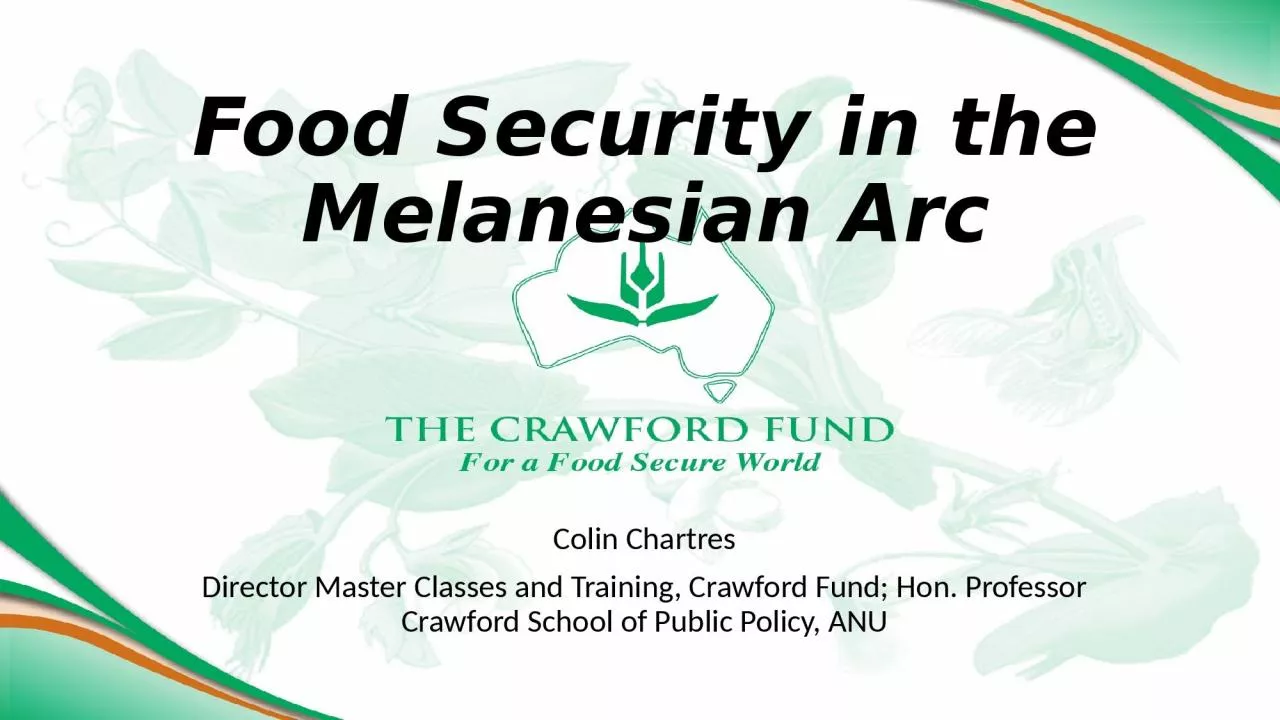

Colin Chartres Director Master Classes and Training Crawford Fund Hon Professor Crawford School of Public Policy ANU Food Security and Political Stability Growing evidence of the relationship between food security and societal unrest ID: 933250
Download Presentation The PPT/PDF document "Food Security in the Melanesian Arc" is the property of its rightful owner. Permission is granted to download and print the materials on this web site for personal, non-commercial use only, and to display it on your personal computer provided you do not modify the materials and that you retain all copyright notices contained in the materials. By downloading content from our website, you accept the terms of this agreement.
Slide1
Food Security in the Melanesian Arc
Colin Chartres
Director Master Classes and Training, Crawford Fund; Hon. Professor Crawford School of Public Policy, ANU
Slide2Food Security and Political Stability
Growing evidence of the relationship between food security and societal unrest
e.g.
in Darfur, Syrian drought, 2007-08
f
ood crisis
Food security is linked to water security and to climate change
What are the risks in the Melanesian Arc?
What can be done to ameliorate these risks?
Slide3Food security
People are
food
secure when they have availability and adequate access at all times to sufficient, safe, nutritious food to maintain a healthy and active life. Food security analysts look at the combination of the following three main elements:
Food availability:
Food must be available in sufficient quantities and on a consistent basis
. It
considers stock and production in a given area and the capacity to bring in food from elsewhere, through trade or aid.
Food access:
People must be able to regularly acquire adequate quantities of food, through purchase, home production, barter, gifts, borrowing or food aid.
Food utilization:
Consumed food must have a positive nutritional impact on people. It entails cooking, storage and hygiene practices, individuals health, water and sanitations, feeding and sharing practices within the household.
Source WFP
Slide4Key global drivers of food security
Population growth
Water scarcity (physical and economic)
Urbanisation (taking over agricultural land and water resources)
Changing land use e.g. biofuel production
Climate change
Slide5Food Security in the Melanesian Arc/PacificApproximately
2.7 million people – one-third of the Pacific population – do not have the income or subsistence production to meet their basic human needs.
Papua New Guinea (PNG), Solomon Islands and Kiribati are among the poorest countries in the world.
Fifteen per cent of the population of Fiji – 120,000 people – live in squatter settlements in urban areas. (Oxfam
)
Slide6Conflating factors
A lack of access to safe water and adequate sanitation is a problem facing people in many Pacific countries, however those in PNG are worse off than most.
The
majority of PNG’s population lives in remote, poorly serviced rural areas sometimes without any road access. The remote Highlands area is troubled by ongoing conflict and is poorer than many other areas.
Despite
having high rainfall, only 10 per cent of the Highlands population has access to safe drinking water. Poor hygiene and sanitation contributes to the spread of preventable but deadly water-borne illnesses.
PNG
faces the worst HIV/AIDS epidemic in the Pacific and, for sufferers, access to safe water can mean the difference between life and death.
Almost 4 million
people
lack access to clean water. Over 3.5 million people lack access to adequate sanitation
.
H
abitat destruction
Pollution from land-based sources
Overharvesting
of resources.
Sources:
AusAID
; Cornell, 'Pacific Urbanisation and its Discontents', 2009; Ministry of Education, Vanuatu; UN MDG Report 2010; Family Planning Int.; Secretariat of the Pacific Community; PNG Demographic and Health Survey; UNICEF; Ministry of Education, PNG; World Bank; UNDP
. ADB (2011)
Slide7Population Trends
Country cultural group
Estimated population
2030
2035
2050
Net migration
2010
Annual Pop growth rate
%
2010
Urban
pop
%Fiji946,320977,5861,060,706(6,489)0.551 (2007)PNG9,899,54910,763,06613,271,05702.113 (2000)Solomons876,394969,9201,245,77402.716 (1999)Vanuatu386,066424,122538,70802.524 (2009)Total12,108,329 13,134,69516,116,244(6489)
Source: ADB, 2011
Slide8Climate Change
The
most direct
effect
, particularly in the smaller atoll countries, will be further
reduction of
already declining agricultural output per capita as a result of increasing natural disasters and
rising sea
level in the longer
term (ADB, 2011).
Specific risks:
Crop and fowl mortality due to excessive heat
Sea water intrusion (salinity and waterlogging)
Drought (particularly during El Nino events)Storms intensityChanging pest and disease factors/vectors (biosecurity risks)
Slide9Natural Resources Context
Tropical climate, summer (Oct-March) rainfall max.
Variable soils from volcanic derived materials in PNG to sandy, infertile and low water capacity soils
Terrain issues in PNG
Slide10Food security issues
Long term food production (yield per hectare) has remained stable; contrasting with 2% growth in the US and Australia
Changes in dietary sources are contributing to obesity and related diseases (30% obesity in Fiji and serious vitamin A deficiencies in PNG)
Greater reliance on commercial markets and greater susceptibility to global price ranges affect poor people
Technological constraints to agricultural production
Declining investment in agricultural R&D
Lack of private sector involvement partly because of poor regulation, land tenure issues, macroeconomic and political instability
Slide11What are the solutions?Start from the premise that many original ag systems in the region provided nutritious and enough food.
Similarly they provided insurance against world market factors and lack of buying power amongst the populations.
However, populations have grown, lifestyles are changing, urbanisation is increasing.
Some “solutions” to combat sea level rise storm intensity
etc.
may have to involve relying on food imports/ food banks etc.
Similarly infrastructure improvement may help improve market access and food distribution.
There are also ways that communities can insure against drought through technical interventions
Slide12Investing in agriculture and environment
Food security can be improved by:
Water storage
Water recycling
Improved agricultural water management including supplementary irrigation
Agronomic R&D including varietal improvement and pest and disease resistance, improved plant nutrition
Agroforestry systems
Protection of terrestrial and estuarine
habitat
But there have to be appropriate governance and policy frameworks for these to happen